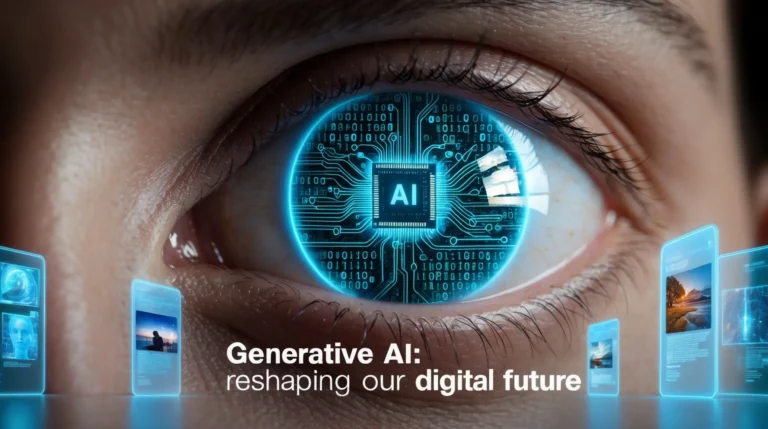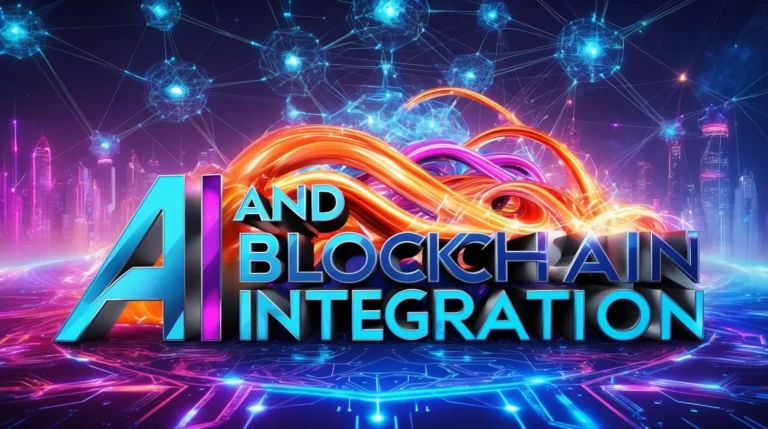The Ultimate Beginner’s Guide to Web3 and Blockchain Technology

Our audience supports Ahcrypto. When you click on the links on our site, we may earn an affiliate commission at no extra cost to you. Learn More.
Introduction
Welcome to the exciting world of Web3 and Blockchain Technology! Imagine an internet where you control your data, interact directly with others without middlemen, and trust the systems because they’re transparent and tamper-proof. Sounds amazing, right? That’s Web3 for you.
Web3 is built on blockchain technology, which you might recognize from cryptocurrencies like Bitcoin and Ethereum. Blockchain is a decentralized record-keeping system that stores transactions on multiple computers, making it impossible to change records. This ensures openness and security, which are the core principles of Web3.
Key Takeaways
- Web3: The next generation of the internet that emphasizes decentralization, user control, and transparency.
- Blockchain Technology: The underlying framework that makes Web3 possible by providing a decentralized and secure way to store data.
- User Empowerment: In Web3, users own their data and assets, interact freely without intermediaries, and participate in governance.
What is Web3?

Web3, often referred to as the next generation of the internet, represents a profound shift from traditional centralized systems to a decentralized model. This transformation aims to give users more control over their online interactions and data.
Definition and Concept of Web3
At its core, Web3 leverages blockchain technology to create a decentralized web where users have ownership and control over their digital assets and identity in the realm of Web3 and Blockchain Technology. Unlike the current internet (Web2), dominated by centralized entities like Google and Facebook, Web3 is built on the principles of transparency, user sovereignty, and trustlessness within the domain of Web3 and Blockchain Technology.
The Role of Decentralization in Web3
Decentralization is a key pillar of Web3. In traditional systems, central authorities control data and operations. In contrast, Web3 disperses these responsibilities across a network of nodes. This setup ensures:
- Enhanced Security: Data breaches are less likely as there’s no single point of failure.
- Censorship Resistance: No central authority can unilaterally change or remove information.
- Trustless Transactions: Users can interact directly without intermediaries, relying on cryptographic proofs.
Understanding Decentralized Applications (dApps)
Decentralized applications (dApps) are software programs that run on a blockchain network rather than centralized servers. Unlike traditional apps:
- Transparency: Every action is recorded on the blockchain for everyone to see.
- Resilience: Being decentralized makes them resistant to censorship.
- Autonomy: They operate via smart contracts, ensuring they execute predefined tasks without human intervention.
Popular dApp categories include:
- Finance (DeFi): Platforms for lending, borrowing, and trading.
- Gaming: Blockchain-based games offering real-world rewards.
- Collectibles (NFTs): Marketplaces for unique digital assets.
The Importance of Digital Wallets
In the Web3 world, digital wallets are indispensable tools for securely managing assets. These wallets:
- Store cryptocurrencies and NFTs.
- Authenticate transactions within dApps.
- Vary in form—browser extensions like MetaMask, mobile apps like Trust Wallet, or hardware devices like Ledger.
Security is paramount when using digital wallets. Always download from legitimate sources and safeguard your seed phrase offline to prevent unauthorized access.
The Evolution of Blockchain Technology
Blockchain technology has come a long way since its inception. From the early days of Bitcoin to the sophisticated platforms we see today, blockchain has continually evolved, revolutionizing various industries along the way.
Development and Progression
The journey of Web3 and Blockchain Technology began in 2008 with the creation of Bitcoin by an anonymous entity known as Satoshi Nakamoto. This marked the introduction of a decentralized digital currency that operated without a central authority. Bitcoin’s success paved the way for other cryptocurrencies and blockchain projects, leading to the development of Ethereum in 2015. Unlike Bitcoin, Ethereum introduced smart contracts—self-executing contracts with the terms directly written into code—opening up new possibilities for decentralized applications (dApps) within the realm of Web3 and Blockchain Technology.
Key Characteristics of Blockchain
Blockchain technology stands out due to several unique characteristics:
- Decentralization: Unlike traditional systems that rely on a central authority, blockchain’s decentralized nature ensures that no single entity has control over the entire network.
- Transparency: All transactions are recorded on a public ledger, allowing anyone to view them. This transparency builds trust among users.
- Security: Transactions on a blockchain are encrypted and linked to previous transactions. This makes it extremely difficult for malicious actors to alter any information.
- Immutability: Once data is added to the blockchain, it cannot be changed or deleted. This permanence guarantees data integrity.
- Consensus Mechanisms: These are protocols used to achieve agreement on the state of the blockchain among all participants. Popular mechanisms include Proof of Work (PoW) and Proof of Stake (PoS).
Understanding these principles helps us appreciate why blockchain is considered a groundbreaking innovation in technology.
Exploring the Components of Web3 and Their Use Cases

The Role of Digital Assets in Facilitating Economic Activities on the Blockchain
Digital assets, such as cryptocurrencies, tokens, or NFTs (Non-Fungible Tokens), are essential for economic activities in the Web3 ecosystem. They allow direct transactions between individuals without any middlemen, creating a system based on trust and transparency. You can own virtual items like artwork or land with digital assets and easily trade them globally. Thanks to platforms like Ethereum, it’s now possible to represent real-world assets as digital tokens on the blockchain.
Understanding Smart Contracts and Their Potential to Automate Agreements in Web3 Applications
Smart contracts are computer programs that automatically execute agreements when certain conditions are met. They eliminate the need for intermediaries by directly enforcing the contract terms through code. Imagine a vending machine that dispenses products or services based on predefined rules – that’s how smart contracts work. This technology within Web3 and Blockchain Technology can potentially revolutionize industries such as finance and law by making processes more efficient and cost-effective. By leveraging Web3 and Blockchain Technology, smart contracts ensure transparency and trust in various transactions.
Exploring Unique Use Cases of Virtual Real Estate in Decentralized Metaverses
Virtual real estate is an exciting concept in the Web3 world. It refers to digital spaces within decentralized virtual worlds where users can buy, sell, and create content using blockchain technology. Platforms like Decentraland offer virtual land where users can build unique experiences, such as virtual stores, art galleries, or even entire cities. This opens up new opportunities for businesses and individuals to monetize their creativity online.
How Community Governance Models Ensure Collective Decision-Making in Web3 Projects
Community governance models play a vital role in maintaining decentralization in Web3 projects. These models empower users to actively participate in decision-making through mechanisms like DAOs (Decentralized Autonomous Organizations). In a DAO, token holders have voting rights on various project development and management proposals. This inclusive approach ensures the community’s voice is heard, making projects more user-centric and transparent.
These components, including AI in logistics and the potential of AI and IoT integration, are essential building blocks of the Web3 ecosystem. Each component serves a specific purpose in enhancing functionality and promoting equal opportunities for all participants.
The Relationship Between dApps, Exchanges, and User Experience in Web3

Understanding the dApps Ecosystem
Decentralized applications, also known as dApps, are the foundation of the Web3 ecosystem. These apps run on blockchain networks and cover a wide range of areas:
- Finance (DeFi): Platforms for lending, borrowing, and trading digital assets without traditional banks.
- Gaming: Blockchain-based games offering rewards and ownership of in-game assets.
- Collectibles: Marketplaces for buying, selling, and trading unique digital items.
Each area offers its own opportunities to engage with blockchain technology, making it more transparent and accessible.
Exploring Different Kinds of Exchanges
In the world of Web3, there are two main types of exchanges available for cryptocurrency trading:
- Centralized Exchanges (CEX):
- They hold your assets for you
- They have user-friendly interfaces
- They offer additional services like staking and savings
- They require you to follow regulations and complete KYC procedures
- Decentralized Exchanges (DEX):
- They don’t hold your assets; instead, smart contracts handle the transactions
- Their main focus is on swapping one asset for another
- They provide transparent transactions without asking for KYC information
- Their liquidity is lower compared to centralized exchanges but is getting better over time
Both types of exchanges are important for supporting cryptocurrency trading, catering to different preferences that users may have.
The Popularity of Non-Fungible Tokens (NFTs)
Non-fungible tokens (NFTs) have changed our thoughts about owning digital items. Unlike cryptocurrencies such as Bitcoin or Ethereum, NFTs are unique and cannot be divided into smaller units. This uniqueness makes them perfect for representing ownership of things like:
- Art: Artists can create NFTs to prove the authenticity and ownership of their digital artwork.
- Music: Musicians can release exclusive tracks as NFTs, allowing fans to directly support them.
- Gaming: Players can own in-game items as NFTs, giving them true ownership and the ability to sell or trade those items.
Specialized marketplaces have emerged to facilitate the buying, selling, and trading of these NFTs. These platforms not only make it easy for people to participate in the NFT market but also drive innovation in various industries.
By understanding how dApps, exchanges, and NFT marketplaces work together in Web3 and Blockchain Technology, users can navigate this decentralized digital world more effectively. To make these platforms even better for users, it’s important to apply SaaS UX design best practices that enhance engagement and encourage long-term usage of Web3 and Blockchain Technology.
Web3 in Practice: Real-World Examples
Web3 and Blockchain Technology are changing how industries work by improving transparency and traceability. One great example is the use of Web3 and Blockchain Technology in supply chain management systems. With blockchain, companies can make sure that every step of a product’s journey—from getting the raw materials to reaching the end user—is recorded and cannot be changed. This openness helps prevent fraud, encourages responsibility, and builds trust with customers.
NFTs: Beyond Digital Art
Non-Fungible Tokens (NFTs) are making a big impact in many areas:
- Art: Artists now sell digital artworks as NFTs, ensuring creators receive royalties on secondary sales.
- Music: Musicians release tracks as NFTs, offering fans exclusive content and ownership.
- Gaming: Games like Axie Infinity use NFTs for in-game assets, allowing players to trade and own unique items.
The Disruptive Potential of DeFi
Decentralized Finance (DeFi) is changing traditional financial services by getting rid of middlemen. DeFi platforms offer:
- Lending/Borrowing: Users can lend or borrow assets without a bank.
- Payments/Transfers: Fast, low-cost transactions across borders.
This new way of doing things makes finance available to anyone with an internet connection.
Web3 has the potential to change many parts of our lives and industries. The move towards decentralization offers a more open and fair digital future.
To fully take advantage of the potential of Web3 and Blockchain Technology, it’s important to see how blockchain technology works together with other advanced fields like Big Data and AI. Web3 and Blockchain Technology, combined with Big Data and AI, can provide valuable insights into how these technologies can drive innovation and success in different industries.
Additionally, AI is transforming industries like e-commerce and cybersecurity. Exploring insights on AI and business strategies from our blog can provide valuable information on leveraging AI’s potential in different sectors.
One of the main areas where AI can greatly impact businesses is improving customer experience. Strategies to Improve Customer Experience with AI can help organizations understand the top 10 strategies to enhance customer interactions using artificial intelligence, thereby staying ahead of the competition.
By combining these technologies into Web3 solutions, we can accelerate the transition to a more open and fair digital future.
Challenges and Future Outlook for Web3 Adoption

Key Barriers to Mainstream Acceptance of Web3 Technologies
Web3 is a groundbreaking paradigm, but several barriers must be overcome for widespread adoption:
- Usability: Current Web3 systems and interfaces can be complex, deterring non-tech-savvy users. Simplifying these interactions is crucial.
- Scalability: Many blockchain networks face transaction speeds and cost issues, especially during high-demand periods.
- Security Concerns: While blockchain technology is secure, the ecosystem has vulnerabilities. Phishing attacks and smart contract bugs pose significant risks.
- Regulatory Uncertainty: Governments worldwide are still figuring out how to regulate decentralized finance and digital assets, leading to an uncertain legal landscape.
The Role of Education and User-Friendly Design
To drive wider adoption, education and design play pivotal roles:
- Educational Initiatives: Awareness programs can demystify Web3 technologies for the general public. Workshops, online courses, and community events can bridge knowledge gaps.
- User-Friendly Interfaces: Intuitive design enhances user experience. Innovations like wallet integrations in browsers or mobile apps simplify asset management.
- Resources: Platforms offering compliance guidance can help businesses navigate this new terrain. Understanding compliance requirements is crucial for SaaS companies, as detailed in this SaaS Compliance Mastery guide.
- AI Integration: Leveraging AI tools to create personalized experiences can make Web3 more accessible. Insights from AI strategies can help reduce biases in decision-making, as discussed in this article on building an effective AI Business strategy with the use of AI tools.
Addressing these challenges through education and improved design will pave the way for a more inclusive and user-friendly Web3 ecosystem.
Conclusion
Web3 and Blockchain Technology can potentially revolutionize how we interact with the internet. Web3 and Blockchain Technology promise to give individuals more control over their data and digital identities by enabling a decentralized, user-centric ecosystem. Imagine a world where your online interactions are not controlled by centralized entities but governed by transparent and tamper-proof systems.
The implications for the future are profound.
- Enhanced Transparency: With blockchain’s immutable ledger, every transaction can be traced and verified, reducing fraud and increasing trust across various sectors.
- Decentralized Finance (DeFi) breaks down traditional financial barriers, allowing for a more inclusive financial system in which anyone can participate without needing a bank account or credit history.
- Digital Ownership: Through Non-Fungible Tokens (NFTs), artists, gamers, and content creators can truly own and monetize their digital assets in ways previously unimaginable.
The journey towards widespread adoption of Web3 is still in its early stages. Key challenges such as user education, security concerns, and the need for more user-friendly interfaces remain. However, Web3’s transformative power is undeniable.
Web3 signals a shift towards a more decentralized, inclusive digital future. As we continue to explore its possibilities, staying informed and engaged will be crucial in navigating this evolving landscape.
Take the First Step into the Future of the Internet!
Feeling inspired by the transformative potential of Web3 and Blockchain Technology? Now is the perfect time to dive in and participate actively in this decentralized digital revolution! Here are a few ways you can start exploring Web3 and Blockchain Technology:
- Try out dApps: Experiment with decentralized applications (dApps) in various categories, such as finance, gaming, and collectibles. Platforms like Axie Infinity offer immersive experiences where you can earn digital assets while having fun.
- Invest in Cryptocurrencies: Educate yourself about cryptocurrencies and consider making informed investments. Digital wallets are your gateway to securely managing these assets. Remember, always use wallets from legitimate sources and keep your seed phrase secure.
- Engage with Communities: Join Web3 communities on Reddit, Discord, and Twitter platforms. These groups help you stay updated and learn from experienced users.
- Stay Informed: Follow reputable sources and blogs and keep up with the latest developments. Understanding the landscape will help you make better decisions and avoid potential pitfalls.
Jumpstart your journey into Web3 today. Whether you’re a tech enthusiast or a curious explorer, there’s a place for you in this decentralized future!
For more insights on optimizing your digital strategies, check out our article on Scaling SaaS: Maximize Scalability for Your Business. And if you’re interested in improving your funds through SaaS optimization, we have another resource on Mastering Saas Optimization to Improve Your Funds.
Join the Web3 Revolution Now!
FAQs (Frequently Asked Questions)

Scott Evans
Hey there, I’m Scott Evans, your friendly guide at AhCrypto! I’m all about breaking down complex SaaS, AI, and tech topics into digestible insights. With me, you’re not just keeping up with the tech world; you’re staying ahead of the curve. Ready to dive into this exciting journey? Let’s get started!





